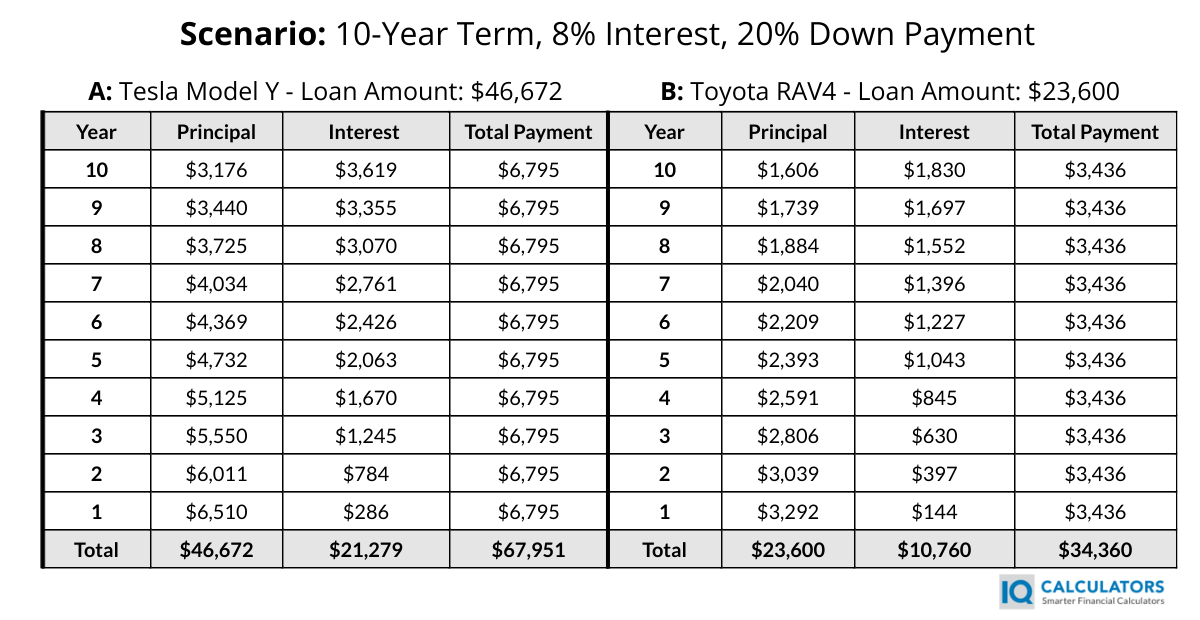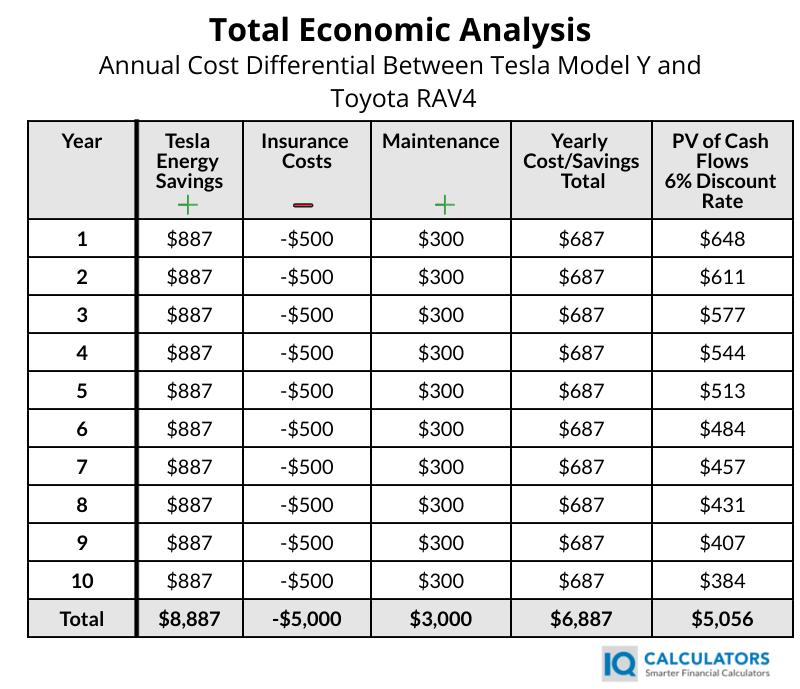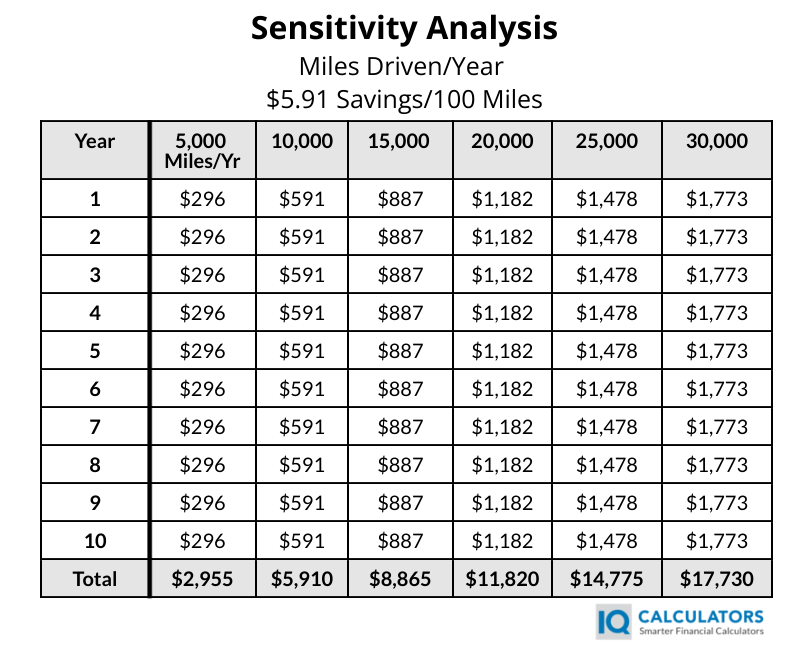Tesla Model Y versus Toyota RAV4: An Economic Comparison
Today, in 2023, the EPA is about to embark on its newest set of regulations for the automotive industry. By 2032, you will likely have a much more limited choice between owning an electric-powered car versus a gas-powered car. It is estimated that if these new regulations are approved by the EPA, nearly 64 to 67 percent of all vehicles sold will be electric by 2032. Furthermore, California has already passed a law that will make gas powered vehicles illegal beyond the year 2035. It will be an interesting path to get to where electric vehicles will rule the road. This is especially interesting given that in 2022, a record number of electric vehicles were sold, amounting to only 5 to 6 percent of the overall total. To reach 64 to 67 percent of vehicles sold being electric in just seven years will require a dramatic shift.
Without having the choice of the energy you want your car to be powered by, it may seem inconsequential to conduct an analysis on which car is economically better for the consumer, but nonetheless, we thought it would be a fun and interesting exercise to analyze these two options. Primarily, we want to analyze the two options economically but in order to evaluate these things, we will also need to analyze the energy-efficiency of each vehicle. And so naturally there will potentially be some overlap with the topic of fossil fuels. However, you won't find any strongly voiced opinions on that topic in this article. This article is simply concerned with solving the problem and calculations to determine which vehicle is better economically for the consumer. At the end of the article, we will share some caveats to this economic analysis to think through.
Before we start, here are some of the assumptions we will make. First, the two vehicles being compared in this analysis are a gas-powered Toyota RAV4 and the Tesla Model Y. The Toyota RAV4 also comes in a hybrid model and an all-electric model called the Toyota RAV4 Prime. it might be more appropriate for us to compare the economics of a RAV4 gas-powered vehicle with a RAV4 Prime, and we might do that in another article. However, since Tesla is the electric vehicle pioneer, this makes the comparison more interesting. It is also noteworthy that the Tesla Model Y became the overall best selling vehicle during the first quarter of 2023. This was the first time in history that an electric vehicle has claimed this title.
Energy Usage Comparison and Savings
When we compare the energy efficiency of each vehicle, first we need to know how far each vehicle can go per unit of energy. For purposes of this analysis, we will assume that the vehicle is traveling long distances down the interstate versus more stop-and-go driving in the city. For the Model Y, it can travel 100 miles on 27 kWh. The US Department of Energy states that 33.7 kWh is equivalent to one gallon of gasoline. On the other hand, the RAV4 can travel 35 miles per gallon. Now, let's condense this down into an apples-to-apples comparison.
If 33.7 kWh is equal to the energy in one gallon of gasoline, then 27 kWh is equivalent to four-fifths of a gallon of gasoline. By dividing 100 miles by four-fifths, we can calculate that the Tesla Model Y will travel roughly 125 miles on the electric equivalent of one gallon of gasoline.
At first glance, this seems like a very dramatic difference and that it should make it a no-brainer decision to buy a Tesla, right? Not exactly...there is much more analysis to be done. First and foremost, the most important factor in our analysis is the purchase price. Today, an electric car is much more expensive relative to a gas-powered car. This means people are paying more upfront for an electric vehicle with the expectation and hope that they will be able to recoup the cost in the form of energy savings during the life of the vehicle.
Secondly, before we convert kWh into an equivalent gallon of gasoline, it's important to understand that just as gasoline has different prices throughout the country(and world), so does a kWh of energy. Interestingly, there is an even more dramatic variance between electricity rates among states than there is between gasoline prices. Here's a comparison of electricity costs per state in 2023.
Here are the five most expensive states for electricity in 2023:
- California: $0.2838
- Massachusetts: $0.2836
- New Hampshire: $02754
- Connecticut: $0.2590
- New York: $0.2264
Here are the five least expensive states for electricity in 2023:
- Idaho: $0.1035
- Washington: $0.1167
- Louisiana: $0.1240
- Utah: $0.1278
- Texas: $0.1279
You can see that the disparity in electricity rates between states is substantial. As you look at the rates, the disparity might continue to increase as many of the most expensive states have increased their energy rates by double-digit percentage points in just the past couple of years, while the less expensive states have maintained their rates.
Now, bringing this back to the comparison of automobiles, someone who buys an electric vehicle in Idaho will benefit much more from buying an electric vehicle than someone in California. This is ironic since California became the first state to mandate electric vehicles. This outsized benefit for Idahoans is especially true since gas prices in California and Idaho are not all that different from each other. A gallon of gas in California in June 2023 costs $4.78 and in Idaho, a gallon of gas costs around $4.25. In contrast, electricity rates from state to state have a much larger variance with California nearly tripling Idaho's rates.
So, for a kWh of energy, we are going to assume that the kWh costs $0.16 cents which is a good middle-of-the-road price in the United States. From here we will calculate the cost savings from using electricity. The variable that will vary on a case-by-case basis is determining how much a person is going to drive. If someone drives a substantial amount each day, week, or year, then an electric vehicle may pay for itself...and that is what we are here to find out.
From here, let's calculate the energy savings per 100 miles to drive a Tesla Model Y versus a gas-powered RAV4. To drive 100 miles in a RAV4 costs 2.8 gallons of gas and at today's prices(2.8 gallons times $4/gallon) equals 11.2 dollars. To drive 100 miles in an electric vehicle costs you 5.39 dollars. This is calculated by taking 33.7 kWh multiplied by $0.16. This means that for every 100 miles driven, the Tesla Model Y will save the owner $5.81($11.2 - $5.39). The image below shows the calculations. From here it is only a matter of determining how much an owner plans to drive each year. See the sensitivity analysis table below.

Sensitivity Analysis - 5,000 Mile Increments
And it is worth noting that if you are a driver in California, the savings become much less per 100 miles due to the price of a kWh costing nearly 30 cents rather than 16 cents.
Purchase Price
The purchase price or the MSRP of the most popular model of a 2023 RAV4 according to Edmunds is $29,500. The purchase price or the MSRP of the most popular version of the 2023 Tesla Model Y is $58,340. There is a large disparity in price between these two vehicles.
These vehicles are at different price points not only because electric vehicles are more expensive than a traditional vehicle, but also because the Tesla is not only an electric vehicle, but it is also competing in a higher-end market. The Tesla is considered by many to be a luxury vehicle. Whereas the Toyota RAV4 is more of an everyday consumer's vehicle and is naturally competing in a lower-end market. For some context, the Toyota RAV4 Prime which is Toyota's electric-powered RAV4 is priced at $43,675 and so this gives you an idea of what portion of the Tesla Model Y's price is due to the fact that they are a higher-end vehicle. Nonetheless, the comparison continues.
The total difference between the purchase price of these two vehicles is $28,840. The Tesla Model Y is just shy of costing twice as much as the RAV4. Now, the question becomes, does the fuel efficiency make up for the difference in the purchase price of the vehicles. And the answer is that it depends on how much you plan to drive and what kind of drives you plan to make. See the section below on "charging versus filling up your tank."
For purposes of this analysis, we are going to assume that both drivers paid cash upfront for the vehicle. However, there is an opportunity cost of paying $28,840 more upfront for a Tesla Model Y. The opportunity cost is the rate of return you could earn on that cash if you were able to invest it elsewhere. Rather, in the case of a vehicle, you are placing your hard-earned money into a depreciating asset whereas it could have otherwise been placed into an appreciating or interest-bearing asset.
And it is important to remember that time is money. To purchase an electric vehicle might save you some money by using electric energy, but if it costs more of your precious time, then this is something to consider to understand if it is really worth it. And again, that is what we are trying to figure out with this analysis.
Financing Options Comparison
Although we won't use financing options in the final analysis, this section will provide a snapshot of the differences that financing a more expensive vehicle can make. When someone chooses to finance a Tesla versus a traditional vehicle, this introduces a new expense. That expense is the interest expense that you will have to pay as a result of the debt.
For example, let's say that the borrower in both cases pays 20 percent as a down payment. For the Tesla, this means a down payment of $11,668 and for the RAV4, this means a down payment of $5,900. The current interest rates on new vehicles are 7 to 8 percent and so we will assume an 8 percent interest rate and a 10-year loan term.
Here's a table showing an example of an amortization table for both vehicles over the course of 10 years and it is surprising how much more interest you will pay for a more expensive vehicle if you choose to finance the purchase. Again, you would need to drive the vehicle even more to realize the energy savings needed. We recommend using the auto loan calculator from IQ Calculators if you plan to receive an auto loan on your next vehicle purchase. This will give you a rough estimate of what your amortization schedule might look like.

Tax Credits
Another factor that needs to be considered is tax credits. Regardless of what you believe about government subsidies, they are part of the EV purchasing equation that needs to be considered as well. Currently, in 2023, for qualifying applicants, there is a $7,500 tax credit to purchase an electric vehicle. This is a substantial advantage to electric vehicles, but does it tip the scales enough to justify buying one? Below we will take this $7,500 savings into account in the final analysis. As you analyze your specific situation, check your state and local governments to see if they offer any EV incentives as well.
Depreciation and Resale Value
This is a variable that is going to be difficult to assess. From 2023 to 2030, the resale value of vehicles may get shaken up quite a bit if the dramatic shift that some expect to happen, does indeed happen. This could mean that Tesla's retain their resale value much better as the demand for electric vehicles increases. It could also mean that gas-powered vehicles might be in high demand.
Regardless of what happens with the new regulations, the website CarEdge looks at expected depreciation rates of vehicles over a 5 year window and according to them, the Tesla Model Y will depreciate by about 39 percent while the Toyota RAV4 will be expected to depreciate only 21 percent. Again, the car market may be in flux over the next several years so these numbers may change, but as it currently stands, the RAV4 has a strong advantage in this category. This equates to the Tesla Model Y losing $22,752 compared to the Toyota RAV4 only losing $6,195 of its value over 5 years.
Maintenance Costs
The average cost of annual maintenance for a Tesla is reportedly approximately $500 to $800 per year. The average cost of maintenance for a traditional vehicle, such as the RAV4 is about $800 to $1000 per year. Given that there are reportedly no fluids such as oil to change in a Tesla, it saves some money on maintenance expenses.
For the analysis of this over a ten year period, we will assume that the Tesla will save $300 per year on maintenance. This equates to $300 per year saved on the Tesla which equals $3,000.
Insurance
The average cost to insure a Tesla Model Y is about $2,000 per year. This is higher than the RAV4 which costs an average of $125 per month or $1,500 per year. This is a $500 savings per year for the Toyota RAV4.
Charging vs Filling The Tank
Although this can't be quantified economically, there is also a time-cost associated with electric vehicles. As technology improves, this will become a smaller factor as charging times become shorter and charging stations become more widely available. But for now, you will need to consider this factor for the type of driving that you do.
Let's say that you are a sales professional and you do day trips to see your customers each day and each day you are able to return back to your house, where you already have a charging station. In this case, this isn't that much of a factor.
On the other hand, let's say you are doing long regional trips between cities. In this case, you will need to consider the charging times and you will need to plan the trip to be able to stop at the proper charging stations along the way. The type of driving you do will need to be taken into consideration.
Bringing It All Together - The Final Analysis
Each section above has looked at a unique part of the automobile ownership equation to determine how much money can be saved, or not, by buying a Tesla Model Y versus a gas-powered Toyota RAV4.
The table below will provide a visual of the different components of savings. Although we present the items in the table below, you need to determine what is important to you. At IQ Calculators, we believe economics is the most important factor to consider when making decisions such as an automobile purchase but others might have other reasons that are more important to them. With that said, here are the results of this analysis from an economic perspective.
The scenarios are numerous and so we can't make all of the analysis in this simple article. If you were wondering how to do the analysis, perhaps this will give you a jumping off point to do the analysis for your unique situation.
Inside this analysis, we do not take into effect financing costs although we demonstrated the potential difference in amortization schedules of the two vehicles above. We also demonstrated the opportunity cost of buying one vehicle versus another one which we will also leave out of the analysis as well. However, we will use a discount rate to discount the future savings back to a present value to determine if the extra expense of the Tesla is justified.

In conclusion, the Tesla Model Y creates a present value savings of $5,056 when considering the savings on energy-efficiency, added insurance costs, and savings on maintenance costs. Now, consider that a person who buys an electric vehicle also gets $7,500 in tax credits. This equates to $12,556($7,500 + $5,056) in total savings. But unfortunately, this doesn't make up for the $28,840 dollar difference in the purchase price between these vehicles. In this scenario, the gas-powered RAV4 is $16,284 cheaper than the Tesla Model Y over a ten-year period. As we shared above, although these are similar vehicles, they are both competing in different categories with the Tesla Model Y being more of a luxury vehicle.
Now also remember, this is one simple, made up scenario where we use a lot of assumptions. But hopefully this provides some guidance on how you can run this kind of economic analysis for your unique situation.

